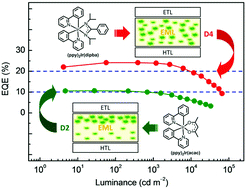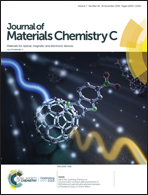Direct monitoring of the recombination zone in highly efficient phosphorescent organic light-emitting diodes based on a high-doping concentration emitting system
Abstract
Four phosphorescent organic light-emitting diodes (PhOLEDs) employing two phosphorescent complexes (ppy)2Ir(acac) and (ppy)2Ir(dipba) doped in a common host material CBP with low/high doping concentrations, respectively, as the emitting layers (EMLs), which were the doping films of CBP:7 wt% (ppy)2Ir(acac) for D1, CBP:25 wt% (ppy)2Ir(acac) for D2, CBP:7 wt% (ppy)2Ir(dipba) for D3 and CBP:25 wt% (ppy)2Ir(dipba) for D4, were fabricated and characterized. To confirm the position of the recombination zones in these four devices and thus explain the different dependence of the electroluminescence (EL) performance on the two dopant phosphors’ doping concentration, a very thin sensing layer (2 nm) was inserted into the different locations of the respective EMLs in D1–D4. The corresponding results showed that the similar EL performances of D1 and D3 could be attributed to almost the same recombination zone in both the devices, where the EL processes were indeed dominated by the CBP host because of their low doping concentration (7 wt%). For the two high-concentration (25 wt%) devices, the remarkably higher efficiency/luminance levels of the (ppy)2Ir(dipba)-based device (D4) than that of the (ppy)2Ir(acac)-based device (D2) could be attributed to the desirable bipolar charge-transporting properties of (ppy)2Ir(dipba). The high-content bipolar phosphor could dominate the EL process and the recombination zone almost broadened as wide as the whole EML in D4 instead of just being distributed in the narrow area near the EML's edge similar to that in D2.



 Please wait while we load your content...
Please wait while we load your content...